
Richmond is the capital city of the Commonwealth of Virginia in the United States. Incorporated in 1742, Richmond has been an independent city since 1871. The city's population in the 2020 census was 226,610, up from 204,214 in 2010, making it Virginia's fourth-most populous city. The Richmond metropolitan area, with over 1.3 million residents, is the Commonwealth's third-most populous.

Harry Flood Byrd Sr. was an American newspaper publisher, politician, and leader of the Democratic Party in Virginia for four decades as head of a political faction that became known as the Byrd Organization. Byrd served as Virginia's governor from 1926 until 1930, then represented the state as a U.S. senator from 1933 until 1965. He came to lead the conservative coalition in the Senate, and opposed President Franklin D. Roosevelt, largely blocking most liberal legislation after 1937. His son Harry Jr. succeeded him as U.S. senator, but ran as an Independent following the decline of the Byrd Organization.

Oregon Hill is a historic working-class neighborhood in Richmond, Virginia. Oregon Hill overlooks the James River and Belle Isle, and provides access to Hollywood Cemetery. Due to the neighborhood's proximity to the Monroe Park Campus of Virginia Commonwealth University, the neighborhood is sometimes referred to as a student quarter because of its high college student population.

The history of Richmond, Virginia, as a modern city, dates to the early 17th century, and is crucial to the development of the colony of Virginia, the American Revolutionary War, and the Civil War. After Reconstruction, Richmond's location at the falls of the James River helped it develop a diversified economy and become a land transportation hub.

The Virginia State Capitol is the seat of state government of the Commonwealth of Virginia, located in Richmond, the state capital. It houses the oldest elected legislative body in North America, the Virginia General Assembly, first established as the House of Burgesses in 1619.

WRVA is a commercial AM radio station licensed to Richmond and serving Central Virginia. WRVA airs a talk radio format and is owned by Audacy, Inc. Established in 1925, WRVA is one of Virginia's oldest radio stations, and the most powerful AM station in the Commonwealth. For much of its history, WRVA billed itself as the "Voice of Virginia."
Alden Peterson Aaroe was a broadcast journalist and announcer for WRVA, a radio station in Richmond, Virginia.
Norge is an unincorporated community in James City County, Virginia, United States.
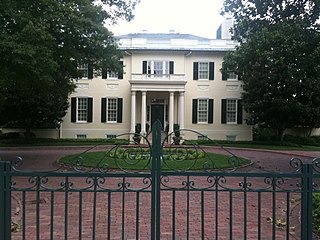
The Virginia Governor's Mansion, better known as the Executive Mansion, is located in Richmond, Virginia, on Capitol Square and serves as the official residence of the governor of the Commonwealth of Virginia. Designed by Alexander Parris, it is the oldest occupied governor's mansion in the United States. It has served as the home of Virginia governors and their families since 1813. This mansion is both a Virginia and a National Historic Landmark and has had a number of renovations and expansions during the 20th century.
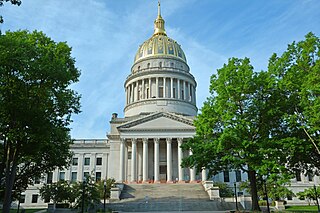
The West Virginia State Capitol is the seat of government for the U.S. state of West Virginia, and houses the West Virginia Legislature and the office of the Governor of West Virginia. Located in Charleston, West Virginia, the building was dedicated in 1932. Along with the West Virginia Executive Mansion it is part of the West Virginia Capitol Complex, a historic district listed on the National Register of Historic Places.
John Tisdale Harding is a long-time on-air personality and News Director for WRVA.
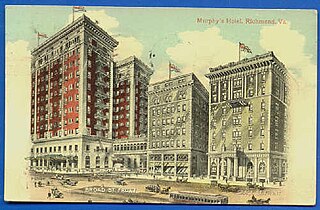
The Murphy Hotel was once a leading hotel in downtown Richmond, Virginia. Its location was at the corner of 8th and Broad Streets and for the last decade was known as the Commonwealth of Virginia's Eighth Street Office Building. The building shared a block with the Hotel Richmond, also known as the state's Ninth Street office building, and St. Peter's Church. It was deconstructed in late 2007 to give way to a modern high-rise that will house offices for the Commonwealth of Virginia.
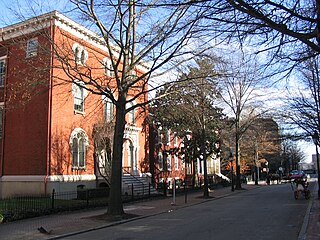
Court End is a neighborhood in Richmond, Virginia, that sits to the north of the Capitol Square and East Broad Street. It developed in the Federal era, after Virginia's capital moved from Williamsburg.

WRNL is a commercial radio station licensed to Richmond, Virginia. WRNL features a sports radio format and is owned and operated by Audacy, Inc. The studios, offices and transmitter are all co-located just north of the Richmond city line on Basie Road in Dumbarton, Virginia.

The WRVA Building is an 18,000-square-foot (1,700 m2) building located at 200 N. 22nd St. in the historic Church Hill district of Richmond, Virginia. Designed by world-renowned architect Philip Johnson while he was at the architectural firm of Budina and Freeman, it was originally built to house WRVA (AM), one of Virginia's first broadcast radio stations. The building is considered "one of the city's most visible and important mid-20th-century architectural landmarks." ChildSavers, a Richmond nonprofit child services agency, is the current occupant.

Frank Pierce Milburn was a prolific American architect of the late 19th and early 20th centuries. His practice was primarily focused on public buildings, particularly courthouses and legislative buildings, although he also designed railroad stations, commercial buildings, schools and residences. Milburn was a native of Bowling Green, Kentucky who practiced as an architect in Louisville from 1884 to 1889; Kenova, West Virginia 1890–1895; Charlotte, North Carolina; Columbia, South Carolina; and Washington, D.C. after 1904. From 1902 Milburn was architect for the Southern Railway.
The following is a timeline of the history of the city of Richmond, Virginia, United States
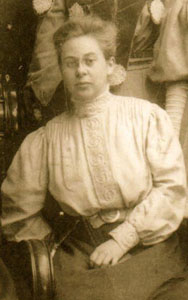
Grace Evelyn Arents was an heiress, Christian activist and philanthropist in Richmond, Virginia. She inherited $1.2 million from her uncle Lewis Ginter, a tobacco magnate and philanthropist, and she used the money to transform Richmond for the better.
Adeline Detroit Wood Atkinson was an American hotelier.
















